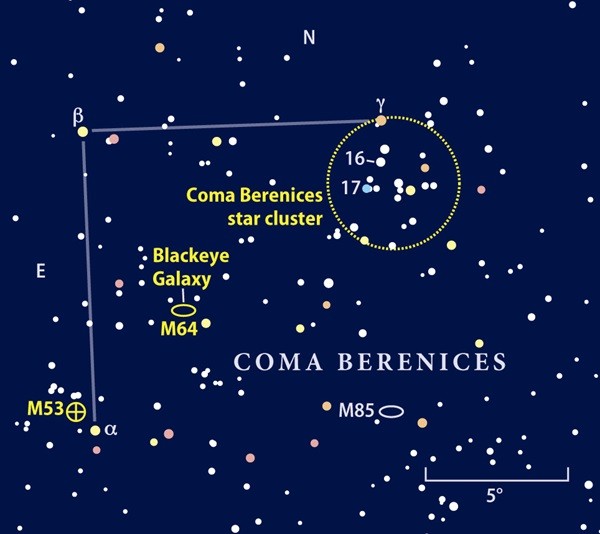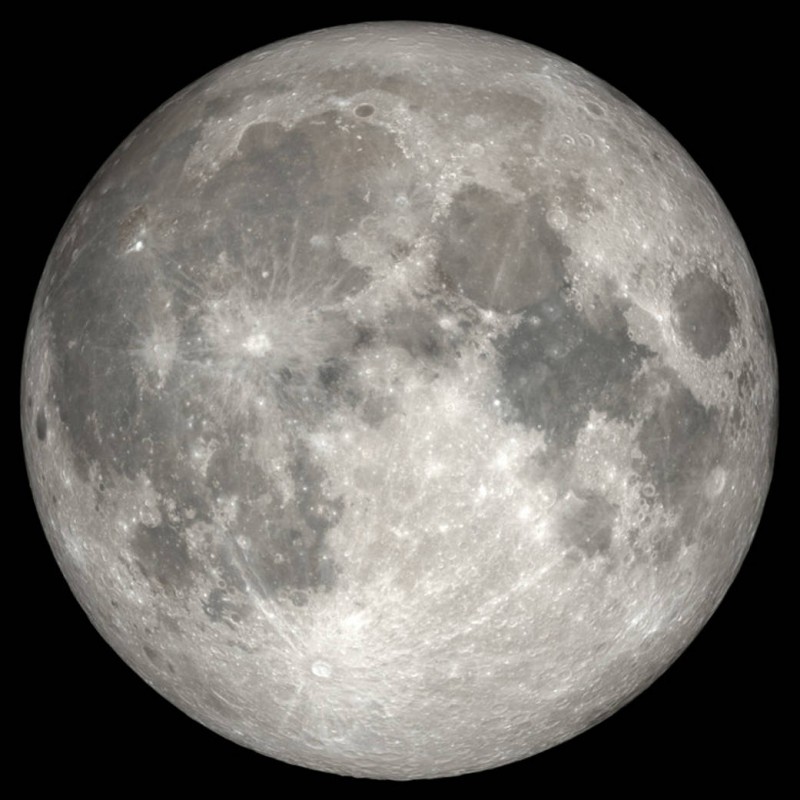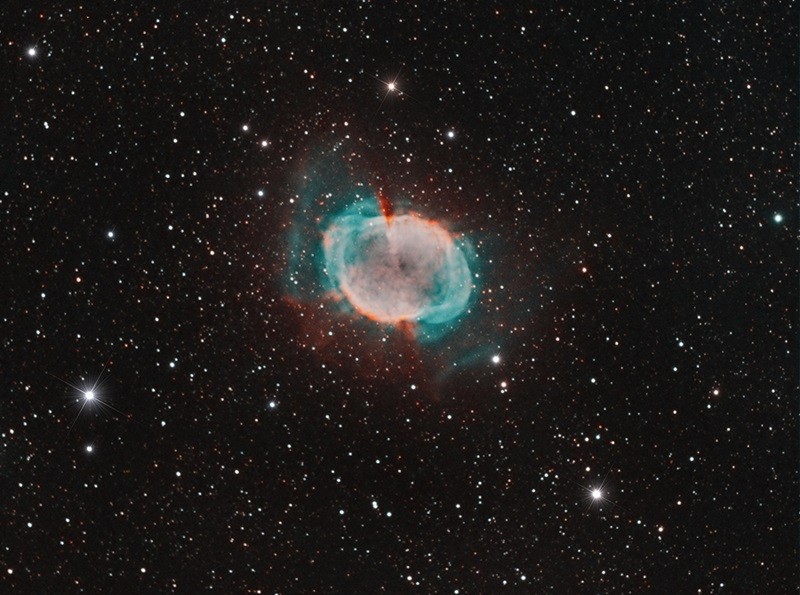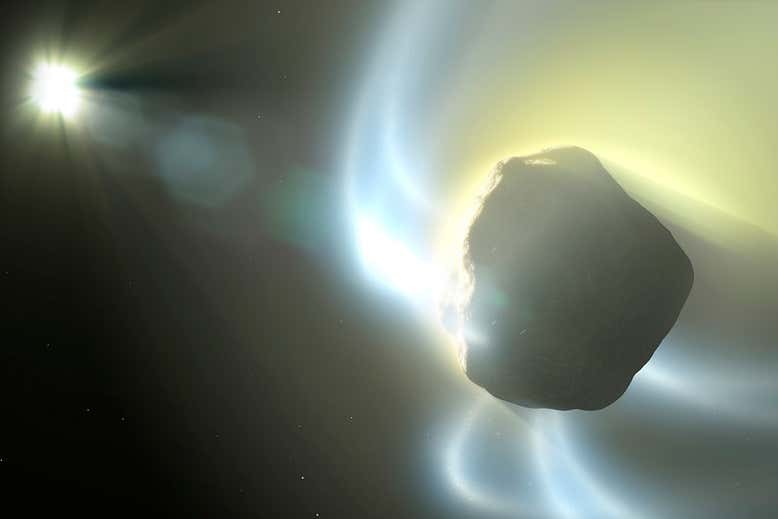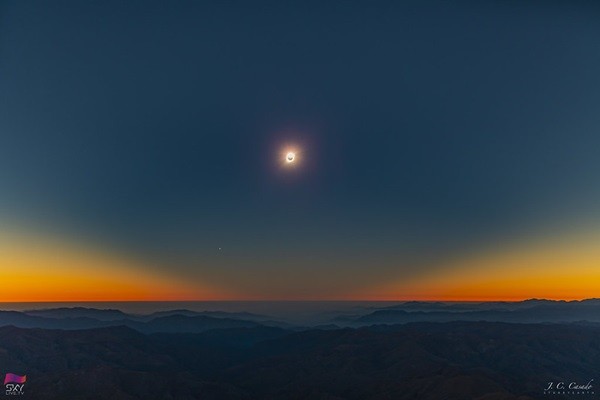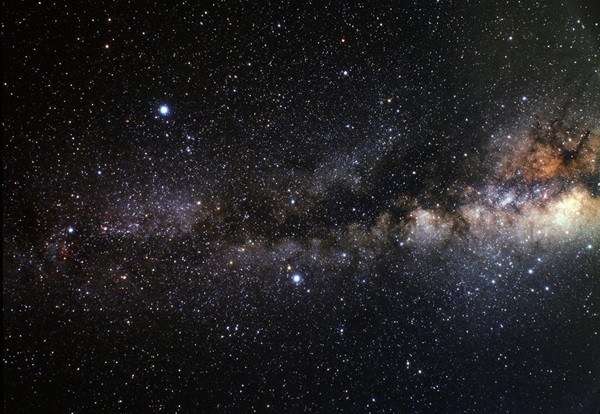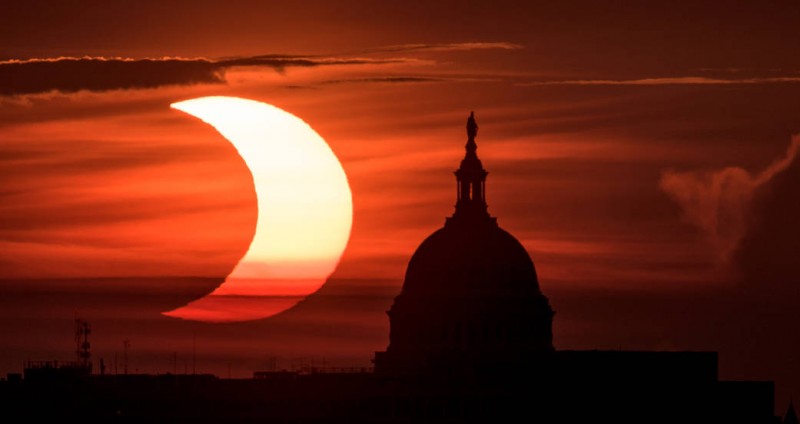Blog
The Sky This Week: Venus meets the Beehive
Tuesday, July 6th 2021 04:48 PM
The Sky This Week: Venus meets the Beehive
Painted Desert Moon & Venus with the Beehive Cluster: This early-morning shot from September 2020 shows the crescent Moon sharing the sky with planet Venus and the Beehive Cluster (M44).
Friday, July 2
July’s early evening skies are given over to a race between Earth’s two closest neighbors: Venus and Mars. The Red Planet starts out ahead, but after a close conjunction about midmonth (stay tuned for more information on that event when it occurs July 13th), Venus will pull into the lead.
Tonight, magnitude 1.8 Mars sits 6° east of Venus, in a sparse region of Cancer the Crab. Venus, blazing brightly at magnitude –3.9, is passing through a more interesting landscape: It’s skipping through the northern reaches of the famous Beehive Cluster (M44), also called Praesepe or the Manger. They’ll set around 10 P.M. local time, and the best way to see them is to turn binoculars or a small telescope on the...
Read More
Read More
The Sky This Week: The Moon and giant planets
Monday, June 28th 2021 05:19 PM
The Sky This Week: The Moon and giant planets
The Queen oversees all: The constellation Cassiopeia the Queen appears at upper right in this image taken near Arlanda Airport in Sweden. Lights from a plane as it takes off have left the wavy line near the horizon.
Friday, June 25
As the Sun sets, Cassiopeia the Queen is starting her upward arc in the sky as she circles around Polaris, the North Star. Cassiopeia is one of several circumpolar constellations, which are close enough to the North Pole that they appear to rotate around it. From many northern locations, such constellations are always above the horizon.
Cassiopeia is easily recognizable as a W-shaped asterism in the sky. That W is facing right-side up early this evening, then slowly turns to stand on its left side by sunrise tomorrow. The stars that make up the asterism are, from left to right, Segin (Epsilon [ϵ] Cas), Ruchbah (Delta [δ] Cas), Navi (Gamma [γ] Cas), Schedar (Alpha [α] Cas), an...
Read More
Read More
NASA Gazes at the Strawberry Moon
Friday, June 25th 2021 04:21 PM
NASA Gazes at the Strawberry Moon
Many cultures name full Moons, and while the names differ, we can all agree that June's full Moon is a sweet sight to behold. The “Strawberry Moon”, as the last full Moon of Spring or the first full Moon of Summer is called, gained its name from the time of year when berries ripen. The name however doesn’t necessarily imply the Moon is red, though it does appear a reddish color when rising or setting. The Moon will appear full for about three days from early Wednesday morning through early Saturday morning. This year the Strawberry Moon is closer and larger than an average full Moon. When we have such a large bright Moon, it is sometimes called a Super Moon.
Whether you call it strawberry, honey, mead, or rose, enjoy the view this evening.
Source: nasa.gov
Read More
Read More
Picture Of The Day
Thursday, June 24th 2021 04:34 PM
Picture Of The Day
Daniel Beaulieu from Quebec, Canada
The Dumbbell Nebula, also known as Messier 27, is a planetary nebula in the constellation Vulpecula the Fox. It lies 1,230 light-years away and carries the distinction of being the first planetary nebula to be discovered. Charles Messier found it in 1764.
Source: Astronomy Magazine
Read More
Read More
'Mega comet' discovered flying into solar system: scientists
Wednesday, June 23rd 2021 04:15 PM
'Mega comet' discovered flying into solar system: scientists
The object has an estimated diameter of 130 to 370 kilometers
A stunning image from the lost Rosetta spacecraft revealed what it would look like to stand on a comet.
Astronomers have reportedly discovered that a large object moving from the outer reaches of the solar system will approach as close as Saturn's orbit in the next decade.
The comet, known as 2014 UN271, was first discovered by the Dark Energy Survey (DES) – an international collaborative project started in 2013 that is listed as working at Chile's Victor Blanco Telescope and was founded with the purpose of mapping galaxies, detecting supernovae and uncovering mysteries about dark energy.
The discovery was announced on June 19, using data from the NASA-funded Minor Planet Center's Minor Planet Electronic Circulars (MPECs).
According to scientists on social media, the hunk of rock and ice has an estimated diameter of around 130 to 370 kilometers....
Read More
Read More
Sun Science Stamps Highlight a Decade of Sun-Watching from Space
Tuesday, June 22nd 2021 06:23 PM
Sun Science Stamps Highlight a Decade of Sun-Watching from Space
To start off the summer, the U.S. Postal Service issued a set of stamps highlighting views of the Sun from NASA’s Solar Dynamics Observatory. Showcasing a range of solar activity seen by the spacecraft, the stamps celebrate a decade of Sun-watching for this workhorse mission. The Sun Science stamps were issued by the U.S. Postal Service during a ceremony at the Greenbelt Main Post Office in Maryland on June 18.
“It’s such a pleasure to see these gorgeous stamps,” said Dr. Nicky Fox, Division Director for NASA’s Heliophysics Division at NASA Headquarters in Washington, D.C. “I look at each of these pictures from the Solar Dynamics Observatory and am reminded of how they help us learn more about the Sun and the way its constantly changing atmosphere can affect Earth and the planets. I’m pleased that this imagery will be shared by the Postal Service with the whole country.”...
Read More
Read More
Image Of The Day - Galveston from Space
Friday, June 18th 2021 04:34 PM
Galveston from Space
On Monday, June 19, 1865, enslaved African Americans in Texas learned of their freedom. That day of liberation became known as Juneteenth, when the Emancipation Proclamation was announced by Union troops in Galveston, Texas.
On Thursday, June 17, 2021, President Joe Biden signed into law legislation making Juneteenth, "a federal holiday, recognizing that (1) history should be regarded as a means for understanding the past and solving the challenges of the future; and (2) the celebration of the end of slavery is an important and enriching part of the history and heritage of the United States," said NASA Administrator Bill Nelson.
This nighttime image, taken by the Expedition 36 crew aboard the International Space Station in 2013, shows most of the metropolitan areas of Texas, with Galveston in the lower right corner.
Image Credit: NASA
Read More
Read More
Did solar eclipses help kick-start human curiosity?
Wednesday, June 16th 2021 08:47 PM
Did solar eclipses help kick-start human curiosity?
As observers digest today's annular eclipse across Canada, Greenland, and Russia, a new paper wonders whether there might be more to solar eclipses than we thought.
A solar eclipse. "It did not look like a dragon," the essayist Annie Dillard once observed, "although it looked more like a dragon than the Moon."
Twenty minutes to totality, thousands of generations ago...
The Sun has withered to a crescent. The Moon's umbral shadow is somewhere to the west, speeding across Earth's surface at thousands of miles per hour. Silently, remorselessly, the Moon takes bigger and bigger bites out of the Sun's disk.
On the ground, a group of our ancient ancestors is blissfully unaware of the events going on above them. The sky dims a little, but the sudden onset of night during the day has yet to come; the Sun remains dazzlingly bright.
These early humans have an intuitive understanding of nature, as well as the familiar changes commo...
Read More
Read More
The Sky This Week: Enter the Summer Triangle
Friday, June 11th 2021 04:42 PM
The Sky This Week: Enter the Summer Triangle
This week of June 11 to 18 brings us familiar summer star patterns and the closest approach of Comet 7P/Pons-Winnecke.
Friday, June 11
An asterism is an unofficial pattern of stars that isn’t one of the 88 officially recognized constellations that cover the sky. The Summer Triangle is a well-known asterism in the Northern Hemisphere sky. Its name comes from the fact that it’s visible all night during summertime in this hemisphere; now, it’s finally visible after sunset, rising in the east as the sky grows dark.
The Summer Triangle asterism returns to the night sky as the summer season approaches in the Northern Hemisphere.
The Summer Triangle comprises three bright blue stars: magnitude 1.3 Deneb in Cygnus, magnitude 0.8 Altair in Aquila, and magnitude 0 Vega in Lyra. Starting at Vega, Altair sits 35° to the southeast. From Altair, look 38° north to Deneb, which also sits east of Vega.
The Summer Trian...
Read More
Read More
Partial Solar Eclipse over the U.S. Capitol
Thursday, June 10th 2021 04:21 PM
Partial Solar Eclipse over the U.S. Capitol
A partial solar eclipse is seen as the Sun rises to the left of the United States Capitol building, Thursday, June 10, 2021, as seen from Arlington, Virginia. The full annular or “ring of fire” solar eclipse visible to some people in Greenland, Northern Russia, and Canada.
Source: NASA/Bill Ingalls
Read More
Read More
